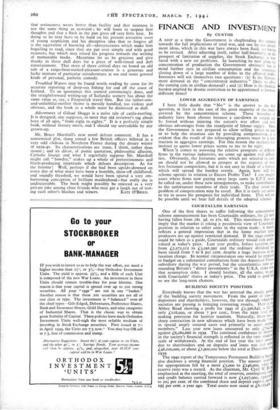FINANCE AND INVESTMENT
By CUSTOS
A STEP at a time the Government is shepherding the country towards the full implications of total war, and one by one invest. ment ideas, which in this war have always been fluid, are havin. to be revised. After adjusting itself, rather half-hearted iv, to the prospect of limitation of supplies, the Stock Exchange is now faced with a new set problems. In launching its new plans for concentration of production the Government obviously has in mind further cuts in civilian consumption and the temporarr closing down of a large number of firms in the affected trades. Investors will ask themselves two questions : (t) Is the Govern. ment demand in the "concentrated industries" likely to offset the coming cuts in civilian demand? ; and (2) How is the financial burden implied by drastic restriction to be apportioned as between different firms?
LOWER AGGREGATE OF EARNINGS I have little doubt that " No " is the answer to the first question, at least in the case of the great majority of the trades covered by the concentration scheme. These branches of industry have been chosen because a cut-down in output can be forced without injuring the nation's war effort and with obvious advantages from the standpoint of labour supply. Since the Government is not prepared to allow selling prices to soar or to help the situation out by providing compensation, it is evident that the result of the telescoping process must be a con- traction in aggregate earnings. For this reason the market's first instinct to quote lower prices seems to me to be right.
When it comes to assessing the relative prospects of different firms in the various industries, we come up against real difficul- ties. Obviously, the fortunate units which are selected to carry on should not be allowed to prosper at the expense of their less fortunate competitors, but it is not easy to think of a formula which will spread the burden evenly. Again, how will this scheme operate in relation to Excess Profits Tax? I can imagine cases where firms now paying away large sums in E.P.T. might be called on, under these new arrangements, to make contributions to the unfortunate members of their trade. To that extent the problem of compensation may be eased. But it is early yet awhile to try to assess the prospects for individual firms. That will not be possible until we hear full details of the adopted schemes.
COURTAULDS EARNINGS
One of the first shares to suffer following the concentration scheme announcement has been Courtaulds ordinary, the LI units having fallen from 28s. 3d. to 27s. 6d. This movement does not imply that the market is taking a pessimistic view of Courtauld position in relation to other units in the rayon trade: it merely reflects a general impression that in the home market Mlle producers are up against restricted demand. If the 1940 earnings could be taken as a guide, Courtaulds ordinary would look under- valued at today's price. Last year profits, before taxation, rng from £2,572,512 to £3,291,392 and the ordinary dividend has been raised from 7 to 8 per cent, despite a huge increase in the taxation charge. In normal circumstances one would be prepared to budget on a substantial contribution from the American Viscose subsidiary during the war period, but the uncertainties now or' rounding Britain's "direct investments" in the U.S.A. make eyed that assumption risky. I should hesitate, all the same, to pan with Courtaulds' shares at today's price. The yield is good alsd so are the long-term chances.
BUILDING SOCIETY POSITION Everybody knows that the war has arrested the steady gr04 of the building society movement. From the point of view i only £H8,000, or about 7 per cent., from the 1939 level aftd
which tiv depositors and shareholders, however, the test through societies are passing is bringing reassuring results. Here is Abbey Road showing a profit for 1940 of £1,396,848, a fan making provision for heavier taxation. Naturally, there W3S, sharp contraction in new advances which have been made "no in special amply secured cases and primarily to assist exisung members." Last year new loans amounted to only L714.41., against £6,280,666 in 1939. The continual confidence of invesst in the society's financial strength is reflected in the very model; scale of withdrawals. At the end of last year the total grit due to shareholders and on deposits and loans was just to' £46,200,000, or about £5,900,000 below the total at December 3 1939. The 1940 report of the Temperance Permanent Building So' also discloses a strong financial position. The amount avai13 for appropriation fell by a mere £5,000 to £146,000, whtl reserve ratio was a record. As the chairman, Mr. Cyril W. emphasised at the meeting, the total of reserves, contingencl and credit balance carried forward is now £1,o57,000, equiv3' to 20ji per cent. of the combined share and deposit capitals 3F„.., x9-1- per cent, a year ago. Total assets now stand at £6,1234'






























 Previous page
Previous page